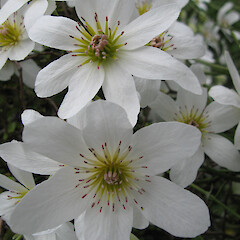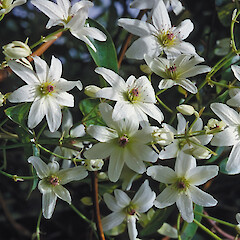Clematis paniculata
Common name
white clematis, puawananga
Synonyms
Clematis integrifolia G.Forst. non C. integrifolia L.; Clematis indivisa Willd.
Family
Ranunculaceae
Flora category
Vascular – Native
Endemic taxon
Yes
Endemic genus
No
Endemic family
No
Structural class
Lianes & Related Trailing Plants - Dicotyledons
NVS code
The National Vegetation Survey (NVS) Databank is a physical archive and electronic databank containing records of over 94,000 vegetation survey plots - including data from over 19,000 permanent plots. NVS maintains a standard set of species code abbreviations that correspond to standard scientific plant names from the Ngä Tipu o Aotearoa - New Zealand Plants database.
CLEPAN
Chromosome number
2n = 16
Current conservation status
The conservation status of all known New Zealand vascular plant taxa at the rank of species and below were reassessed in 2017 using the New Zealand Threat Classification System (NZTCS) – more information about this can be found on the NZTCS website. This report includes a statistical summary and brief notes on changes since 2012 and replaces all previous NZTCS lists for vascular plants.
Please note, threat classifications are often suggested by authors when publications fall between NZTCS assessment periods – an interim threat classification status has not been assessed by the NZTCS panel.
- Conservation status of New Zealand indigenous vascular plants, 2017 . 2018. Peter J. de Lange, Jeremy R. Rolfe, John W. Barkla, Shannel P. Courtney, Paul D. Champion, Leon R. Perrie, Sarah M. Beadel, Kerry A. Ford, Ilse Breitwieser, Ines Schönberger, Rowan Hindmarsh-Walls, Peter B. Heenan and Kate Ladley. Department of Conservation. Source: NZTCS and licensed by DOC for reuse under the Creative Commons Attribution 4.0 International licence.
2017 | Not Threatened
Previous conservation statuses
2012 | Not Threatened
2009 | Not Threatened
2004 | Not Threatened
Distribution
Endemic. North, South and Stewart Islands. Naturalised on Chatham Island.
Habitat
Coastal to montane in shrubland or tall forest (up to 1000 m a.s.l.).
Wetland plant indicator status rating
Information derived from the revised national wetland plant list prepared to assist councils in delineating and monitoring wetlands (Clarkson et al., 2021 Manaaki Whenua – Landcare Research Contract Report LC3975 for Hawke’s Bay Regional Council). The national plant list categorises plants by the extent to which they are found in wetlands and not ‘drylands’. The indicator status ratings are OBL (obligate wetland), FACW (facultative wetland), FAC (facultative), FACU (facultative upland), and UPL (obligate upland). If you have suggestions for the Wetland Indicator Status Rating, please contact: [Enable JavaScript to view protected content]
UPL: Obligate Upland
Rarely is a hydrophyte, almost always in uplands (non-wetlands).
Detailed description
Robust high-climbing evergreen woody vine. Main stems woody up to 200 mm diameter at base, branching in upper ½ or less, bark grey-brown, furrowed, branchlets stout, pliant, glabrescent. Leaves dark and glabrous above, pale green and sparsely covered in white hairs beneath, 3-foliolate, (50-)-70-130-(10) × 60-120(-190) mm; leaflets coriaceous, broadly ovate to broad-oblong, cordate to truncate at base; margin entire to crenately toothed or lobed near apex, rarely deeply lobed to almost dissected; petiole (20-)30-60(-70) mm long. Flowers unisexual, in compound axillary dichasial cymes. Bracts paired; lower pair often leaf-like, united, usually inserted below middle of pedicel. Male flowers: sepals 6, imbricate, white, glabrous above, hairy beneath, spathulate to obovate or oblong, 25-35(-60) × 8-15-(24) mm; stamens numerous; anthers 1.5-2.0(-2.5) mm long; filaments sparsely hairy or glabrous. Female flowers: sepals 6, similar to male, (16)-20-25-(40) × 7-10(-13) mm; staminodes few. Achenes hairy, 2-4 mm long. Style (2.5)-3.5-6.5 cm long at fruiting, plumose. Fruits not persistent.
Similar taxa
None - the usually entire, dark green, leathery leaves, and big white flowers serve to distinguish it from all indigenous, naturalised and exotic species in New Zealand, except C. armandii which differs from C. paniculata by its much larger leaves with lanceolate lobed leaflets and smaller white flowers.
Flowering
July - November
Flower colours
White
Fruiting
October - January
Life cycle
Pappate achenes are dispersed by wind (Thorsen et al., 2009).
Propagation technique
Easily grown from seed. Can be grown by cuttings but these can be fickle and slow to strike. Prefers to be planted a permanently damp but not sopping soil, in a situation where it can grow up into the sun. Its root stock should never be allowed to dry out. In humid climates prone to powdery mildew.
Etymology
clematis: From the Greek klema ‘vine’, alluding to the vine-like habit of many species
paniculata: Small sprayed
Attribution
Description adapted from Webb et al. (1988)
References and further reading
Esler, A.E. 1969. Leaves of Clematis paniculata. Wellington Botanical Society Bulletin, 36: 40
Thorsen, M. J.; Dickinson, K. J. M.; Seddon, P. J. 2009. Seed dispersal systems in the New Zealand flora. Perspectives in Plant Ecology, Evolution and Systematics 11: 285-309
Webb et al. (1988), Flora of New Zealand Vol. IV. DSIR Botany Division, Lincoln.


























